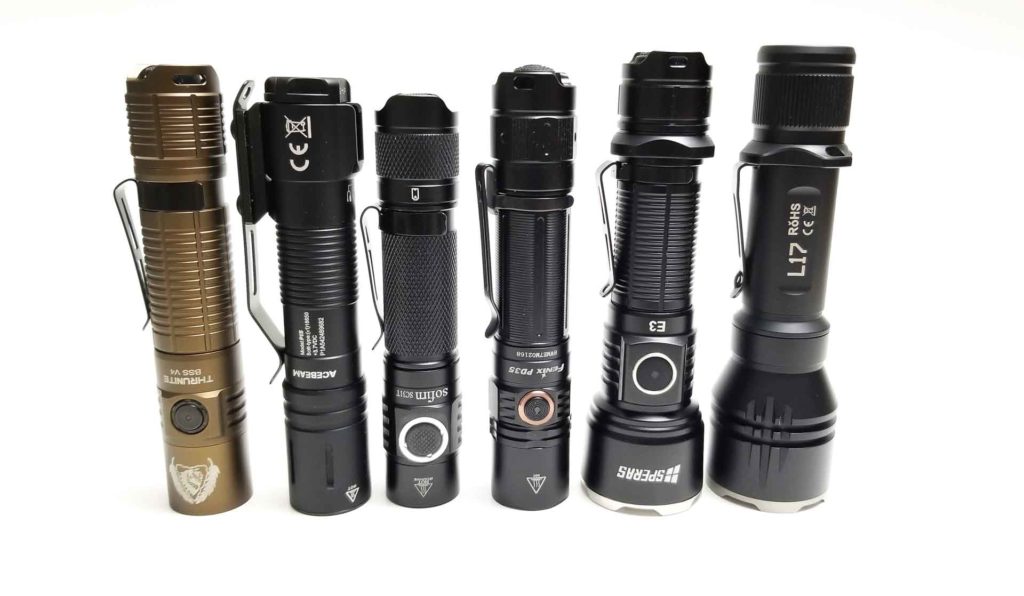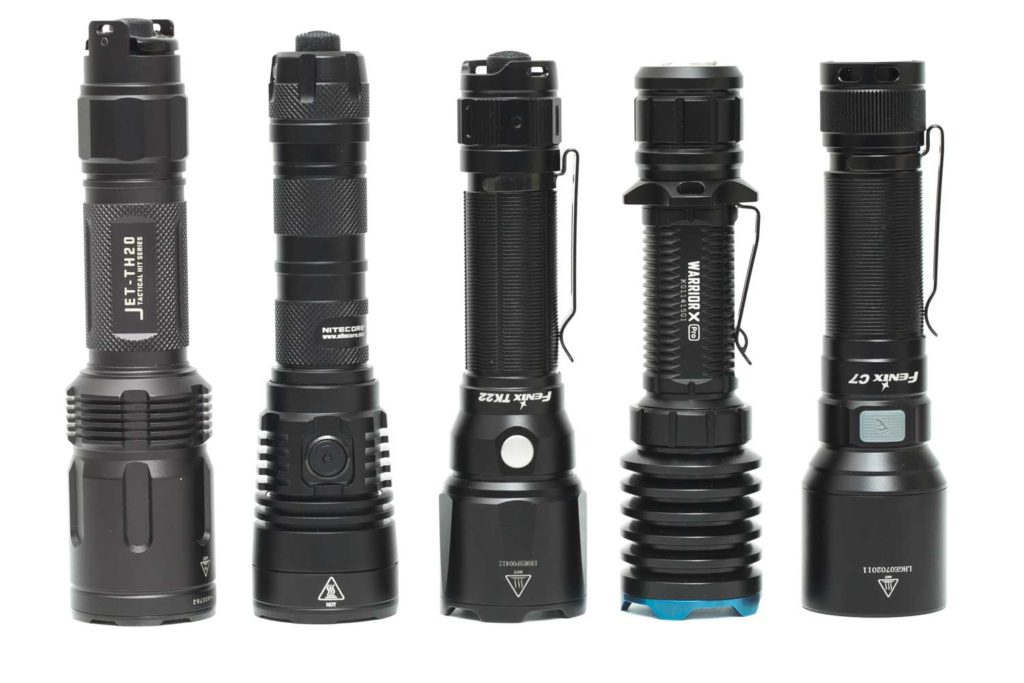What’s a tactical flashlight?
Let’s start by saying that a tactical flashlight is not a ‘weapon flashlight’. In fact, there are many flashlight made for weapon mount use.
A tactical flashlight can be used in conjunction with a firearm, but you can also see it as a tool for self-defense.
What features should a real tactical light have?
As I illustrated in the beginning, a tactical light is not the same as a pistol light or WML (weapon mount light). Although WML lights can be part of your tactical gear. So, in a sense, they are related, but there’s a clear distinction between pistol lights and weapon mount lights.
And let’s be clear, most flashlights that are sold as ‘tactical flashlights’ on Amazon are not tactical at all. Oh, and don’t ask me about all the ‘military flashlights’ over at eBay. Those are just junk. Educate yourself, and stay away from those.
And since this is a flashlight review site, we have reviewed hundreds of flashlights, so we made a list with some of the best tactical flashlights we tested so far.
Here are a few pictures of the tactical flashlights we reviewed.



Before jumping into more details, let’s do a quick summary:
- Should have 1 button to turn the light on and off with the same brightness! (Regular flashlights with 1 switch usually use the same button to change modes, but that isn’t very handy in critical situations where you should trust your flashlight and not skip modes from high to low for example).
- Should have a strobe option that can be accessed quickly/instantly, in a high stress scenario.
- Should be waterproof.
- Uses a forward clicky at the rear end of the flashlight so you can turn the light on and off without pressing the button completely (a reverse clicky switch need a complete press and will turn on after the click, while a forward clicky will power the light on before the click, as it’ll activate much earlier), so you can put your thumb on the bottom and decide how long you press the button to use the light, instead of having to click a second time to turn the light off.
- In most cases, they include some kind of strike bezel or crenelated bezel, in order to use it for self-defense or as a non-lethal weapon. Being trained in using it helps tremendously, and without training, such a feature is usually not necessary.
- Mode order is best to go from High to Low, unless you have a special Tactical switch with instant access to Turbo/high/strobe.
User interface
One of the most important aspects in my opinion is the UI.
Imagine you being in a situation where you need a lot of light, immediately. You don’t want to press that switch 3 times thinking you entered the highest mode, forgetting that you actually activated strobe. Or, holding the switch for 2 seconds to turn on, but actually activating the lockout feature. (A lockout mode is actually deactivating your light, where you can’t use the flashlights anymore unless you unlock the light again. Great for EDC, not so for most tactical flashlights). Also, check out our Tactical flashlight vs EDC flashlights page.
The UI should be as simple and straightforward as possible, with direct access to the highest output (usually Turbo), and if possible direct access to Strobe. And no, Anduril based flashlights (a popular firmware for EDC flashlights used by flashlight enthusiasts) should never be considered for tactical use, emergency use, or self-defense. If people recommend one with that software, just ignore them, even if they tell you you can customize the firmware. And I don’t agree a tactical light should have a 1 lumen mode… A 5-10 lumen mode for low, is low enough.
Simply put, you want to have a UI without programmable features. The light should turn on whenever you hit that switch, and not accidentally hit a useless ‘programming/configuration/lockout mode’. And having a forward clicky switch helps in case you need the light for signaling / morse coding.
Oh, and in many cases, tactical lights have accessories and mounts to attach them to a rifle/gun, but you can still use it without. Unlike a pistol light.
Batteries
Go primary or rechargeable? Or a hybrid?
Many tactical flashlights we reviewed accept 2* CR123 batteries besides a single 18650 battery. But if you have access to lots of CR123 batteries (maybe because of your work), and you still want to use rechargeables, keep this in mind.
CR123A batteries are often interchangeable with 16340 rechargeable batteries, but their Voltages are different. A primary CR123 battery has a nominal voltage of 3V, while the 16340 lithium-ion battery has 4.2v when fully charged. That’s quite a difference. And especially if you have 2 batteries in series. That would mean: 2*CR123 3v = 6V, but 2*16340 4.2v = 8.4V.
Please make sure what type of batteries the flashlight you choose accepts. And many of the tactical flashlights we reviewed accepted 2*CR123 or 1*18650. That’s safer than replacing 2*CR123 with 2* 16340 batteries.
Please note: we don’t test our lights with CR123 batteries for our reviews. There are many types of CR123 batteries, and testing all modes with these batteries costs us a lot, (each mode will eat 2 batteries) we normally don’t test our lights with CR123 batteries.
Bezels and reflectors
I don’t normally recommend spiky bezels or strike bezels, but in some cases, they can be useful. Think about the moments as a first responder and you need to break a window of a car. I’d still recommend using a crenelated bezel with short teeth that doesn’t have too many pointy parts, so you can carry it in your pockets without damaging them or hurting yourself.
But something that you need to keep in mind is the reflector or TIR optics the bezels are protecting. Glass lenses that protect plastic reflectors are probably the most common, but in some cases, TIR optics can be a better choice (especially when they are protected by a glass lens). With TIR optics, they are really made for 1 specific purpose, concentrating the beam, and controlling the spill of the beam. Glass lenses (with the traditional flashlights) can actually break while dropping your flashlight on the floor and cause more bad than good.
LEDs and beams
This is quite related to the reflectors being used, but what type of beam are you looking for.
Do you want something to use for close range, or do you need a light to identify things/people in a distance? The type of LED is as important for Tactical lights as they are for EDC flashlights. And no, I don’t think you need to care too much about the CRI rating. Other factors are much more important for a tactical flashlight. And I have never read a thread of a police officer or first responder complaining about the CRI of their tactical light :–)
What are some of the best Tactical Flashlight brands?
When it comes to popular tactical lights, I’d recommend looking at the following brands we have reviewed:
- Acebeam (L17, L18, L19, L35)
- Fenix (TK series, including TK35, TK16 v2, TK11, etc)
- Olight (Warrior series)
- Nitecore (TM series)
Other brands like Surefire and Streamlight might be added here as well, but we haven’t reviewed any of them.
Oh, and I don’t recommend buying the J5 Tactical flashlight you see on Amazon!.. Why not? Because it’s junk, and not tactical: https://budgetlightforum.com/node/62870 . It’s not the brightest flashlight, it’s not tactical, it’s not great, it’s horrible. Any website recommending them (and there are many if you look for the best tactical flashlights) should be ignored for all advice concerning flashlights.. period..